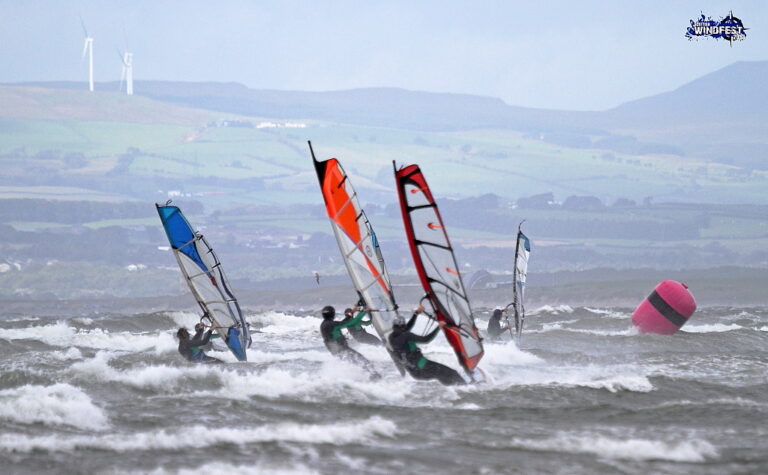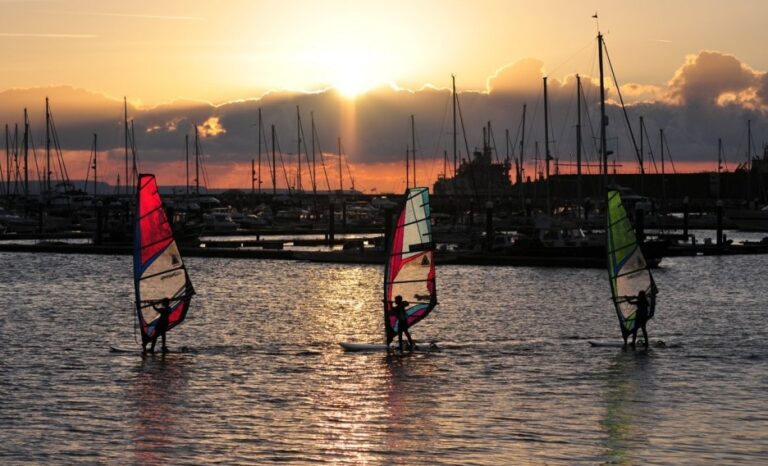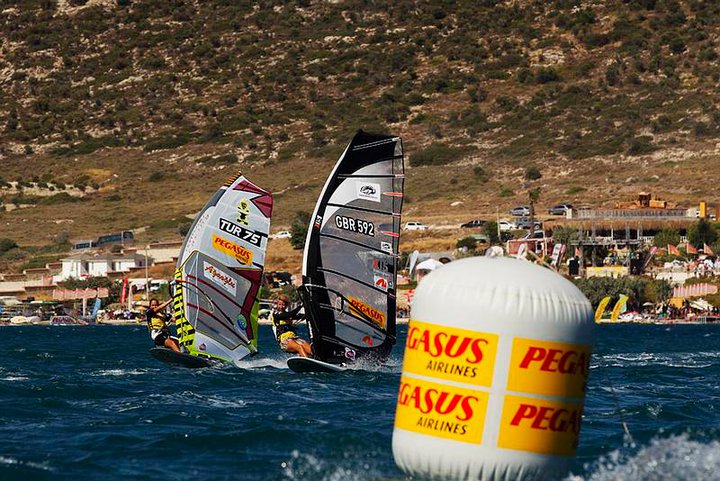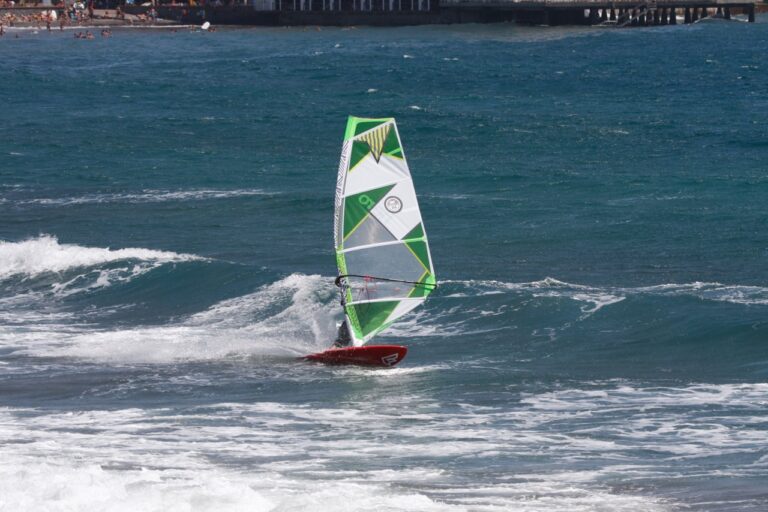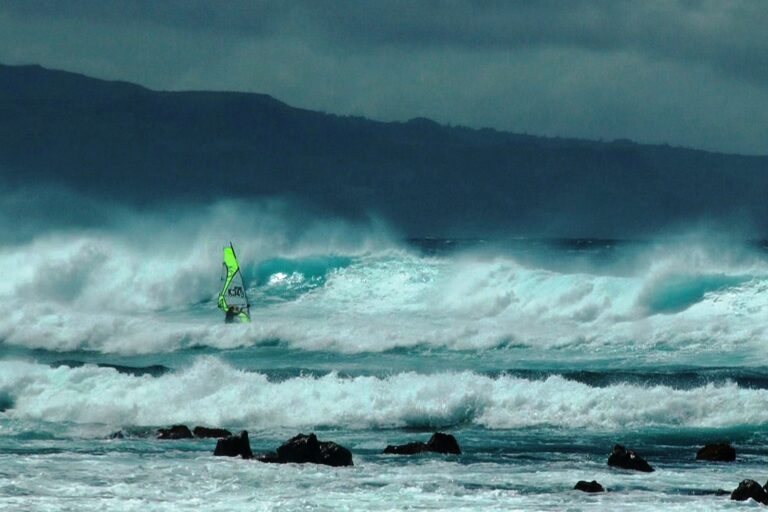Join BOARDS for the second part of our ‘Day at the Races’ with some of the world’s best slalom racers and some Cape Town locals talking you through the must have slalom skills…
Overtaking
As the pack starts to spread out, you can concentrate on trying to establish a lead, or hunt down the guys in front of you. Catching up is one thing, but what next?
Ross: “Going to overtake someone along a reach is usually best from the top as you will have clean air, but if you know the sailor has less boat speed than yourself, you can also come up behind him and then dip below at the last second. If it’s you that is defending off another guy, then you can usually push them up or downwind. A reach is not so long; so, if you can successfully block him once or twice you should be able to hold him off into the gybe. Then you need to make sure your gybe is good and his bad, so that you have a chance to get away from him down the next reach. A lot of the time the chasing sailor will go too fast into the gybe, so if you are smart you can force him out wide and he will lose a lot of ground.”
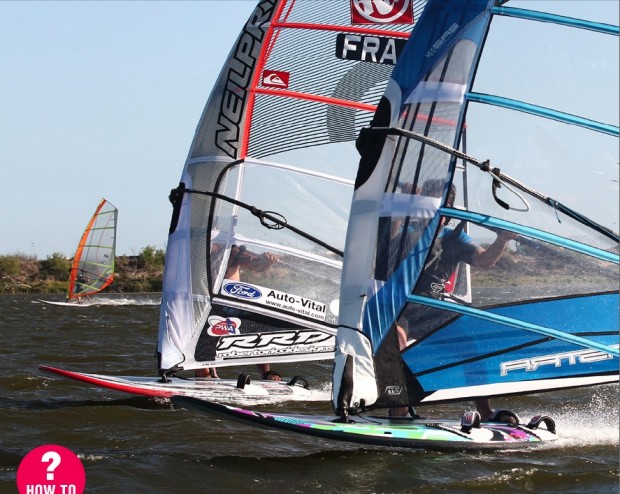
Antoine: “Everybody on the course has quite similar speed, so it is really hard to overtake someone in a straight line. If you overtake someone usually it is at the gybe. If someone makes a mistake at the gybe, you would jump at the opportunity to take them.”
Lena: “If you’re the one trying to overtake, stay out of the bad water of the person ahead of you, and if you are not fast enough to overtake in a straight line – then at least you should try and put yourself in a good position for going into the gybe and overtake your opponent there.”
Hennie: “Coming out of the gybe build up to top speed as soon as possible. Then go slightly to windward, which puts you in a better position to defend your position. If you are upwind of other sailors and they want to pass to leeward just sail in a position to give them dirty air. It is very difficult to pass to leeward of anyone unless you have Antoine’s level of speed. If someone wants to pass to windward of you then head up and squeeze him for space and at the last minute head down towards the mark.”
More corners
Just as you start to get your rhythm, you are presented with another opportunity to get further ahead, or claw back another place. 100% success rate with speed and fluidity is the key here – as is pumping, if it is necessary!
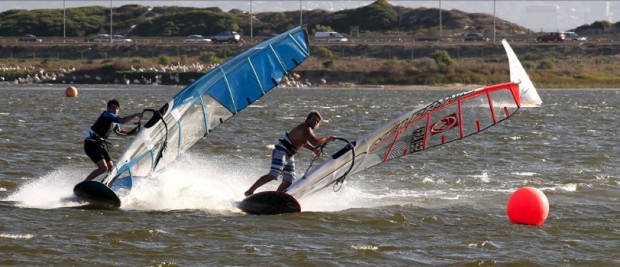 Ross: “Keeping your speed through the gybes is highly important. So best is to practice as much as you can and in all conditions. Alone or with friends and it doesn’t have to be on slalom gear. Remember you are in a race so acceleration out of the gybe might depend on you having to pump your ass off. A lot of guys on tour are pretty lazy so you can improve your results by a lot just by working harder and never giving up in a race.”
Ross: “Keeping your speed through the gybes is highly important. So best is to practice as much as you can and in all conditions. Alone or with friends and it doesn’t have to be on slalom gear. Remember you are in a race so acceleration out of the gybe might depend on you having to pump your ass off. A lot of guys on tour are pretty lazy so you can improve your results by a lot just by working harder and never giving up in a race.”
Lena: “Bending your knees, having your back hand far down on the boom and switching your feet early are all important tips to keep your speed up through the gybe.”
Hennie: “Getting sorted out quickly and back in the footstraps and hooked in quickly is really important. The sooner you can start applying full power, the sooner you get away from the pack. More time is made and lost here that anywhere else on the course.”
Mitch: “Best way to keep speed through the gybe would be to try keep a nice smooth arc, while keeping the power on through the sail to drive you through the arc. You have to really commit to the gybe otherwise the gybe becomes more sloppy with unclear direction for the board making you slower.”
Robbie: “In light wind, when I look at Antoine, Ross and especially Lena, they are gybing in the most energy proficient way and it seems like they are hardly using up their energy reserves. I also notice that the pros are not trying anything too fancy or radical, they simply concentrate on a tight arc and a fast exit. I was very impressed with Ross as he has a seamless gybe that looks so simple and his sail flip is so perfectly timed when the board is still on a downwind course that he hardly loses any momentum. It really is amazing as they go into a gybe together, how close the three of them will gybe, sometimes literally cm apart. Something that really stuck with me was Antoine’s ability to get back into the straps after his gybe. Usually, I end up fighting with my back foot especially in overpowered situations and the board seems to go upwind as I prod, poke, and pulverise my toes into submission before finding the strap. Antoine seems to get his feet back into the straps very quickly and he is in a position to accelerate when I am floundering around. Another thing I noticed about the pros was they got their feet into both straps before hooking into their harness. I sometimes just get my front foot in and then hook in to save energy before trying to negotiate with my back foot. Obviously I have it wrong as they all quickly get the feet in the straps before hooking in.”
The dash for the line
In an event with a lot of heats during a day or a weekend, consistency is everything. And even more importantly – It isn’t over ‘till its over, there’s fat ladies singing, and you are back in the clubhouse sipping a cold one!
Ross: “Most of the time the race is decided before you reach the finish line, but sailors can and do make mistake, hit things in the water, or lose concentration – so I will never give up till I am sure I have crossed the finish line. Give every race 100%.”
Antoine: “Sometimes the race is like a procession. If everyone makes their perfect race with a good start and fast gybes, then there are no changes from the start to the finish – and that is why the start is SO important! On the last reach sail the shortest line to the finish, or if you are chasing, go deep downwind to pick up speed for a chance to overtake below.”
Mitch: “Most of the time it is a battle to the finish line with a very close finish. Always try to check where the other racers are around you. They may try to bear down on you from above and overtake upwind of you, aiming to slow you down by taking your wind. Or, they may be downwind of you bearing hard downwind to hit the very end of the finish line to try and sneak a position form you. You need to react quickly to this and don’t give up till you cross the line.”
Hennie: “Rely on position and speed and sail the shortest possible line to the finish. Look around and don’t relax at this point, defend your position early if someone makes a move.”
Learning from others
Our CT locals reflect on a key lesson – training with your peers or better sailors – will improve your technique and confidence, particularly in the gybes, when you are forced to gybe where the buoy is, not where the flattest water is.
Robbie: “Just being able to shadow someone like Antoine taught me so much as I was able to study his stance, follow his starts and take note of his gybes as I followed in his wake. Going flat out was an eye opener as what I thought was fast was simply idling for Antoine and Ross. All I would hear is this clatter of carbon as they cruised passed me. I kept on looking down to check if I had weed on my fin and at one point thought that I had mistakenly left my fin cover on. Antoine never seems to have his front arm any other way but absolutely extended and straight with his body extended outwards allowing his weight to do all the work. His arms seem to be totally relaxed as if they are just resting on the boom for show. I learnt so much just by sailing behind him and trying to adjust my cramped up style, as I have been using my hands to partly hold the sail, and did not use my full body weight to its potential. As soon as I put full trust and weight into my harness and tried to emulate his style, my speed immediately improved. Ross also helped me with my foot strap positioning, telling me that I needed to tighten my back straps to get me more onto the edge of the board especially in lighter conditions. Adversely the opposite to this in strong winds, where the straps should be loosened to allow my foot a little further in, giving me more control.”
Hennie: “You always think you are quick in a straight line relative to your local spot or at national level, until you sail in a slalom format against the likes of Antoine and Ross. They are just always exactly on time and at full speed on the start line. They always seem to be in clear air and take 10 to 20m out of you on any run. Then they go around the marks with no loss of speed and control. I think where they make up the most distance is in that awkward moment when you are 3/4 of the way through the gybe, you have just flipped the sail and moved your feet. While you are trying to get back in the straps and hooked in, the top boys just keep on flying and open up many meters in every gybe. This obviously adds up and gets you to the front at the end of the race.”

